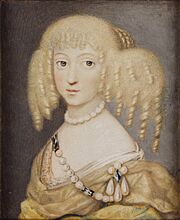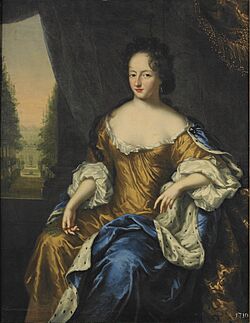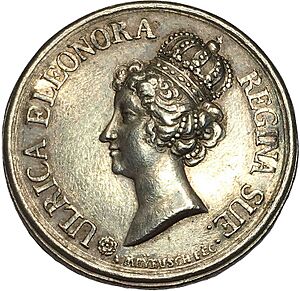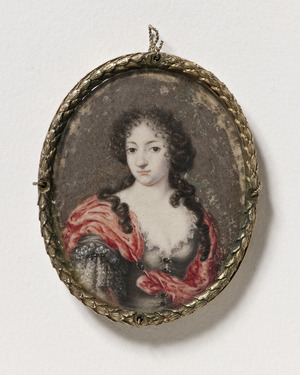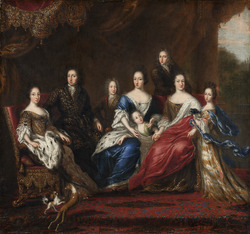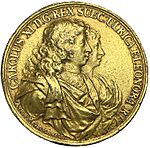Ulrika Eleonora of Denmark facts for kids
Quick facts for kids Ulrika Eleonora |
|
|---|---|
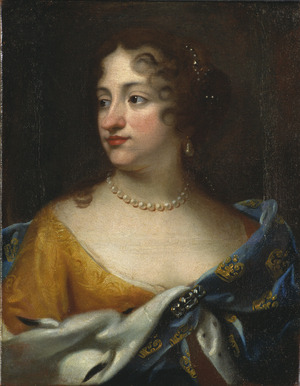
Portrait attributed to Jacques d'Agar, 1677
|
|
| Queen consort of Sweden | |
| Tenure | 6 May 1680 – 26 July 1693 |
| Coronation | 25 November 1680 |
| Born | 11 September 1656 Copenhagen |
| Died | 26 July 1693 (aged 36) Karlberg Palace |
| Spouse | |
| Issue Among others... |
|
| House | Oldenburg |
| Father | Frederick III of Denmark |
| Mother | Sophie Amalie of Brunswick-Lüneburg |
| Signature | |
Ulrika Eleonora of Denmark (born September 11, 1656 – died July 26, 1693) was the Queen of Sweden. She became queen by marrying King Charles XI. People often remember her for being very kind and generous.
Her name, Ulrike, is a Danish version. In Swedish, she is called Ulrika Eleonora den äldre. This means Ulrika Eleonora the Elder. This helps people tell her apart from her daughter, who also became queen later.
Early Life & Royal Marriage
Growing Up in Denmark
Ulrika Eleonora was the daughter of King Frederick III of Denmark-Norway. Her mother was Queen Sophie Amalie of Brunswick-Lüneburg. She had a strict upbringing, guided by her mother. She learned many languages and was good at drawing and painting.
Engagement to King Charles XI
In 1675, she became engaged to King Charles XI of Sweden. This marriage was meant to stop Denmark from joining Sweden's enemies. Her brother, the King of Denmark-Norway, was not keen on the match. But their mother really wanted it to happen. She knew it would make Ulrika a queen. The engagement was announced on July 13, 1675.
Loyalty During Wartime
During the Scanian War (1675–1679) between Denmark and Sweden, some wanted her to break the engagement. Her brother even tried to end it in 1676. But Ulrika still saw herself as engaged to Charles XI. She refused other marriage offers.
She showed great loyalty to Sweden during the war. She was kind to Swedish prisoners of war. She even sold her jewelry, including her engagement ring, to buy them food, clothes, and medicine. She also refused to celebrate Danish victories over Sweden.
Marriage Plans & Journey to Sweden
Peace talks between Sweden and Denmark started in 1679. Her marriage to Charles XI was part of the peace deal. It was confirmed on September 26, 1679. The marriage contract was signed on February 6, 1680.
The Swedish representative, Johan Göransson Gyllenstierna, escorted her to Sweden. During a celebration, her name and Charles's name were written with fireworks. Ulrika's name faded first. She said she hoped it meant she would die first. She could not imagine living without her husband.
Ulrika Eleonora was loved in Denmark for her kindness. When she left for Sweden, her brother, Christian V, returned her pawned jewels. She thanked the Danes, hoping they would always remember her with love. She also hoped her marriage would bring lasting peace between Denmark and Sweden.
Life as Queen of Sweden
Royal Wedding & Coronation
Ulrika Eleonora arrived in Helsingborg, Sweden, on May 4, 1680. She was greeted with cannons, the Queen Dowager, and the Swedish court. Two days later, she married Charles XI at Skottorp Manor on May 6, 1680. The wedding was quick and simple.
The King wanted to avoid the French ambassador. So, the wedding was kept secret and happened sooner than planned. On November 25, 1680, she was crowned Queen at Storkyrkan in Stockholm.
First Impressions & Popularity
At first, Charles XI was not impressed by her looks. But he was told she had "an angel" inside her. Ulrika Eleonora was known for being religious, patient, and kind. She was seen as a symbol of peace and was very popular with the public.
She showed courage even before reaching Stockholm. Her boat almost sank on Mälaren lake. She calmly told everyone: "Be still, do not cry out so! If we shall die, it will be the will of God."
Ulrika Eleonora quickly became popular. She sent almost all her Danish staff back home. She said her husband and his ministers would take care of her. She was given her own court and money. But she chose to let the King's officials manage her finances. She believed this would help relations with Denmark.
Life at Court & Family
At the royal court, Ulrika Eleonora was often overshadowed by her mother-in-law. Charles XI always put his mother first. His mother, Hedvig Eleonora, never fully gave up her position as the main queen. She always took the most important place at events.
This caused some tension between the two queens. However, there was never an open fight. In 1686, Ulrika Eleonora left Stockholm for a while. She stayed at Uppsala Castle with her children. This was likely due to her unhappiness with her husband's closeness to his mother. She later returned to Stockholm.
Despite this, her family life with Charles XI and their children was happy. Her husband was faithful to her. On his deathbed, he said he had not been happy since she died. Ulrika Eleonora herself once called her mother-in-law "The Devil of my marriage."
Interests & Social Life
Ulrika Eleonora's health was often weak, especially after many pregnancies. This sometimes stopped her from attending royal events. At Karlberg Palace, she enjoyed a happy family life away from court. She also loved painting.
She was interested in theater and dance. She supported amateur plays at court. In 1683–84, a group of noblewomen performed the first Swedish play by an all-female cast. This was a French play called Iphigénie. Ulrika Eleonora wanted to be in it, but she was pregnant.
Her close friends included her confessor Johan Carlberg and her lady-in-waiting Maria Elisabeth Stenbock. She also enjoyed visits from her sister, Princess Frederica Amalia of Denmark, and her husband, Christian Albert, Duke of Holstein-Gottorp.
Charity and Influence
Ulrika Eleonora did not have much political power. Charles XI preferred to talk about state matters with his mother. She once tried to help nobles whose land was taken by the crown. But the King told her he did not marry her for political advice.
Instead, she secretly helped these people with her own money. She would buy their jewels and then give them back. Over time, Charles XI trusted her more. In 1690, he named her as a future regent. This meant she would rule if their son became king while still a child.
Ulrika Eleonora is most famous for her amazing charity work. She started many helpful organizations. She sometimes sold her own things to pay for her projects.
Her well-known projects include:
- The Tapetskolan vid Karlberg: A tapestry school at Karlberg Palace, started in 1688. Orphan girls learned to make tapestries there.
- The Drottninghuset ('Queen's House'): A home for poor widows in Stockholm, founded in 1686.
- A poor house at Kungsholmen.
She also sent food and help to areas suffering from bad harvests. This included Finland in 1687 and Estonia in 1688. She paid medical bills for many people in Stockholm.
In 1682, she asked Johan von Hoorn to organize midwifery in Sweden. She died before it was finished. But her own midwife, Catarina Wentin, helped publish the first book on childbirth in 1697. Ulrika Eleonora also gave money to many people regularly. This included injured soldiers, and people who changed their religion to Protestantism. In 1693, she supported 17,000 people.
Death and Legacy
Final Days
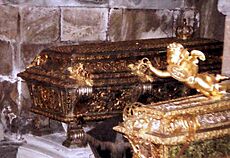
By 1690, Ulrika Eleonora's health was very weak from childbirth. She had an illness that kept her in bed for weeks. Doctors suggested she go to hot baths in Germany. Money was set aside for this trip. But she said she was in God's hands in Sweden too. She used the money for her charity instead.
King Charles XI personally cared for her at Karlberg Palace. She died there on July 26, 1693. She had spent the winter of 1692–93 in bed.
Last Wishes & Mourning
On her deathbed, she gave advice to her children. She told them to be humble and help others. She also asked her husband to be kind to those who lost their property. She asked for a simple funeral. She wanted the money saved for it to go to the poor. Charles XI reportedly said: "Here I leave half of my heart."
Many people mourned her deeply. Countess De la Gardie said: "I do not believe any royal to have been so mourned as Her Majesty." Ulrika Eleonora is remembered as a saintly queen. Frans Ferdinand Carlson wrote: "Seldom has a more lovable creature been placed upon a throne. She thought of everyone but herself."
Charles XI did not give her a simple funeral. But he gave the same amount of money to the poor. He ordered two years of mourning for the court. He refused to marry again, even though people wanted him to.
Her body was kept at Karlberg Palace for several months. She was buried in the fall of 1693 at Riddarholmen Church.
A Famous Legend
There is a well-known legend about her death. It says that while the queen was dying, her favorite lady-in-waiting, Countess Maria Elisabeth Stenbock, was sick in Stockholm. On the night the queen died, Countess Stenbock supposedly visited Karlberg. She was let into the room where the queen's body lay.
A captain named Stormcrantz looked through the keyhole. He saw the countess and the queen talking by the window. He was so shocked he started coughing blood. The countess and her carriage were gone the next moment.
When this was checked, it was found that the countess had been very sick in bed that day. The King ordered that no one should talk about it again. Countess Stenbock died a few weeks after the queen. Captain Stormcrantz also died soon after.
Royal Children
Ulrika Eleonora and Charles XI had seven children:
- Hedwig Sophia Augusta (born June 26, 1681 – died December 22, 1708); she married Frederick IV, Duke of Holstein-Gottorp.
- Charles (born June 17, 1682 – died November 30, 1718); he became King of Sweden. He died at age 36 and never married.
- Gustav (born June 14, 1683 – died April 26, 1685); he died as a young child.
- Ulric (born August 2, 1684 – died June 8, 1685); he died as a baby.
- Frederick (born October 7, 1685 – died October 22, 1685); he died as a baby.
- Charles Gustav (born December 27, 1686 – died February 13, 1687); he died as a baby.
- Ulrika Eleonora (born January 23, 1688 – died November 24, 1741); she became Queen of Sweden. She married Prince Frederick of Hesse-Kassel. She died at age 53 and had no children.


